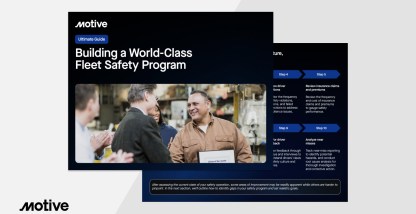Regular coaching as part of a fleet safety program helps build a safety culture and reinforces just how important safety is to your company. The results can pay off in fewer accidents, better driver retention, and even lower insurance costs.
The most advanced fleet safety programs blend in-person, remote, and automated coaching. Combining all three leads to more frequent, proactive sessions that keep safety top-of-mind and help nip bad habits in the bud.
As you build a comprehensive coaching and fleet safety program, make sure you start with executive buy-in. Executives need to support your efforts — and drivers need to know that coaching is a top organizational priority. If your leaders are hesitant to invest in a program, itemize the costs of not investing in a safety program.
When you roll out the program to your fleet, explain why you’re doing it. Create a safety contract or commitment letter for everyone to sign. And then continue to update the entire fleet on the program’s successes and lessons.
Who should be my fleet safety program coach?
Designate at least one person as a dedicated driver coach. And don’t just add “run coaching program” to an already-full plate. Ensure that your coach has enough time to do the program justice.
Your ideal coach should:
- Have the experience and authority to lead the coaching program. They could be a supervisor or a senior driver respected by their peers.
- Be a good listener, someone to whom drivers will feel comfortable admitting mistakes.
- Seek certification through a nationally recognized defensive driving program such as the National Private Truck Council (NPTC) or the Smith System.
Depending on the size of your fleet, you may need more than one coach. Regardless, it’s smart to designate a back-up in case your primary coach leaves or takes time off.
And don’t overlook the power of self-coaching. As part of your fleet safety program, empower your drivers to take ownership of their own actions and development by providing continual access to safety tips, videos, or other tools.
Guidelines for effective coaching
No matter where or when you’re coaching, the basics are the same:
Have a plan
For each session, draft a short agenda that will keep the conversation focused and ensure you’re using your time wisely. Think about which one or two points you want to really drive home.
Listen more than you talk
Allow pauses to let your driver respond. Ask questions about their experiences, whether you’re reviewing recent incidents or discussing new policies. Then listen to their answers before reacting.
Assess whether a driver’s skills or behaviors need improvement
Sometimes a newer driver lacks skills that could be learned through a defensive driving course. Other times, bad habits are at fault. The difference is important.
Establish common ground
Even if it’s a supervisor-employee relationship, you’re on the same team, with the same goal: to stay safe and do right by your customers. Make sure to emphasize how important this is in your overall fleet safety program.
Make the costs of bad behaviors relatable
Help drivers understand what their actions mean for the fleet and their own livelihood. Explain the rising costs of accidents, convictions, or nuclear verdicts — but also the risks of a suspended or revoked license. For example, commercial drivers with two serious traffic violations in three years face a minimum 60-day revocation, which increases to 120 days for a third violation.
Share the positive, not just the negative
Drivers who only hear negative feedback may grow discouraged and tune you out. Strive to share the positive, too. Point out how a driver’s quick thinking averted a collision, or note how they improved a behavior. Consider rewarding desirable actions through a driver incentive program.
Document each session
Noting what was discussed in each session allows you to track progress, identify patterns, and demonstrate improvements to management, your team, or your insurance broker.
This tracking is easy to do right in the Motive Driver App.
Blend coaching methods
While the most effective coaching tends to be in-person, that’s not always practical. Weave in remote coaching (via phone or video chat) to reinforce your lessons, plus automated, self-directed coaching that can encourage your driver to continuously improve. Consider assigning training (whether in-person or online), paired with assessments to confirm learning. You could also periodically distribute incident video and ask your drivers to be prepared to discuss it at your next team meeting.
Invest in the right technology
In-cab alerts from the Motive AI Dashcam can reinforce your coaching lessons right in the moment, when a real-time correction matters most. Additionally, drivers can review their own post-trip footage in the Motive Driver App. Motive also automatically scores incidents to identify the most severe events, helping you focus your coaching efforts.
Stress that drivers can come to you, any time
Keep an open-door policy. To build trust, tell drivers that they can reach out any time with questions or concerns, even if there’s no coaching session scheduled.
Track and reward success
Set metrics that will reflect your efforts. Over time, share results with your entire team, and even your insurance carriers. Reward improvements and thank drivers for their efforts. Metrics might include:
- Number of coachable events per million miles
- Accidents per million miles
- Average cost per claim
- Motive Safety Score
Add coaching to your fleet safety program to see results
Ready to get started? Download our guide to launching a safety coaching program, then request a demo to see how Motive can help you to build a safety culture in your fleet that delivers results.










